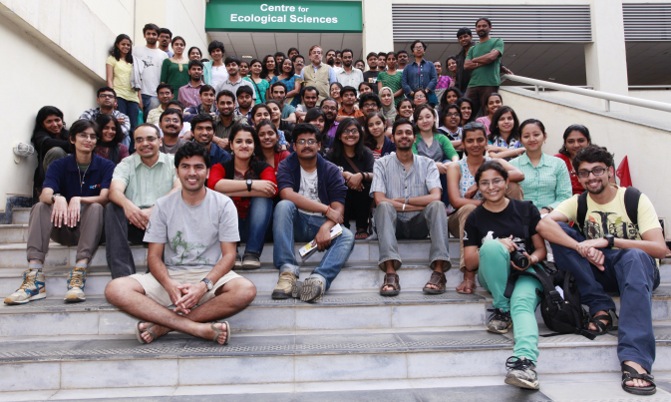A glimpse of the CES in-house symposium 2014, organized by the Ecology Students Society
Sun, 2014-01-19 10:21
Day 1: (by an anonymous student)
Like any other major activity of our department, the ‘CES In-house Symposium’ was organized by the active student body of the Centre for Ecological Sciences, known as Ecology Students Society or popularly by its acronym ESS. The event began at 9:30 on 17th Jan 2014 that saw an assortment of talks ranging from the acoustics of communication among crickets, to investigating whether human induced stress levels in elephants (by measuring gluco-corticoid metabolite levels in their dung), to the limits of homing abilities of wasps, to changes in land-use patterns in Bangalore, to the response of butterflies to lantana invasion. We also had a talk on accounting for shrinkage when trying to estimate the growth of trees. This was really fascinating – I never knew that tree girth can and does reduce in response to water-stress. One topic that was most suitably brought up shortly before lunch was on including phylogenetic diversity assessments of sites in informing conservation decisions. This sparked off several debates both during and after the talk and led to much reflection on the motivation for conservation and the functional interpretation of diversity estimates, among other issues.
One of the most enjoyable aspects of working at CES is the diversity of research that one gets to engage with here. Some of the talks were by experienced PhD students who had tackled challenging research problems for nearly four to five years, pretty much summarizing their entire PhD journey, while others were upstarts just beginning their journey and looking to explore newer horizons. Topics ranged from highly specialized to general. However, the simplicity and broad perspective with which they were all presented enabled everyone to participate in discussions across the board - from more theoretical puzzles in ecology such as coexistence of species that occupy identical niches or the evolution of altruism, to examining the relationships between different diversity indices in order understand processes governing species richness gradients, to applied ecology problems such as how to measure diversity independent of species richness or the use of techniques used in the analyses of animal movement in the characterisation of community dynamics and quantification of resilience in real-world ecological data.
In summary, it was a celebration of everything that research in ecology encompasses. Looking forward to more tomorrow!
Day 2 (by Viraj Torsekar):
The CES in-symposium offered a lot of variety in breadth and depth representing the variation in ecological systems that researchers at CES try to study. One of my favourite talk on the second day was by Prof. Gadagkar. He elegantly explained the theories explaining worker policing in honeybees to get across an important message; be wary of falling in love with your favourite theory. Instead, he advised everyone to work harder on trying to disprove their favourite theory. The theory would acquire added legitimacy if it withstood this onslaught and emerged unscathed. He also cautioned students regarding the resistance people would put up if one attempted to ‘rock the boat’ or challenge the status quo.
My other favourite talk was by my lab-mate Samira Agnihotri, a PhD student from Dr. Rohini Balakrishnan’s lab. Samira spoke about vocal mimicry in the Greater Racket-tailed Drongo. The audience was astounded to hear recordings on how it mimicked the calls of a mammal and a cricket! Samira combined human and computer assessment of call spectra of different calling models and the mimic. The computer algorithms employed in this technique in collaboration with Prof. Chandrasekhar from Electrical Engineering in IISc are normally used for human speech recognition. Human assessment involved asking 105 untrained volunteers about their choices of the best match between model and mimic spectra from the provided options. Sabiha Sachdeva, a joint student between Ecological sciences and Physics department working in Vishwesha Guttal’s lab, presented a computational model inspired from statistical physics that could predict abrupt transitions in complex ecosystems. These inter-departmental collaborations show that ecology is an interdisciplinary science, and our own department is increasingly embracing it.
Phylogenetic techniques are being used to address diverse questions in CES. Aniruddha Dutta Roy spoke about the interesting biogeographic patterns he’s been generating from studying the 2 large families of Skinks (a type of lizard) found in India. Dr. Deepak Veerappan, his lab mate from Dr. Praveen Karanth’s lab, put up some of his data obtained from sampling for Sitana (another type of lizard) in parts of peninsular India. Kunal Arekar, also from the same lab, reasoned that Hanuman Langurs, which are identified as one species, is almost surely a species complex and presented some evidence towards that effect. Nitin Saxena from Vishwesha Guttal's lab is trying to see if there are phylogenetic patterns in the evolution of collective movement behaviour in fish.
Talks were complemented by visually appealing presentations and presenters mostly stuck to their allocated time, exuding professionalism. The lucidity of presentations was admirable with almost every speaker getting the point of their talk across to the audience. This was evident from the nature and number of questions that followed every talk. Talks were also peppered with comic interludes provided by students chairing the 8 sessions. These chairpersons had been asked to introduce the speakers in a manner in which the audience wouldn’t forget and they did not disappoint.
At the end of the symposium, a healthy discussion followed where lots of ideas to keep informal gatherings going throughout the year were proposed. One of my favourites (now, is that a surprise?) was to offer any sort of food to incentivise such gatherings and making the phrase ‘food for thought’ literal. The symposium, now well on its way to being an annual event, is becoming a fantastic avenue for everyone to meet each other and discuss their work.

Add new comment